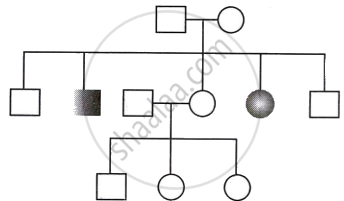Advertisements
Advertisements
Question
Explain polygenic inheritance pattern with the help of a suitable example.
Solution
Human skin colour is an example of polygenic inheritance. It is caused by a pigment called melanin. The quantity of melanin is due to three pairs of polygenes (A, B and C). Very dark or black colour is due to the presence of dominant alleles (AABBCC). Very light or dark colour is due to the presence of all recessive alleles (aabbcc). Intermediate colour is often shown in the F1 generation when a dark or a black colour individual marries a white colour individual. Such an offspring is called mulatto (AaBbCc). When two such individuals of intermediate colour marry, the skin colour of the children will vary from the very dark or black to the very light or white.

APPEARS IN
RELATED QUESTIONS
A single pea plant in your kitchen garden produces pods with viable seeds, but the individual papaya plant does not. Explain.
In a cross between two tall pea plants some of the offsprings produced were dwarf. Show with the help of Punett square how this is possible.
How would you find genotype of a tall pea plant bearing white flowers? Explain with the help of a cross. Name the type of cross you would use.
Mention any two contrasting traits with respect to seeds in pea plant that were studied by Mendel.
A polygenic inheritance in human beings is ______.
______ is a type of trait whose phenotype is influenced by more than one gene.
Multiple phenotypes is seen in:
A, B, D are three independently assorting genes with their recessive alleles a, b, d respectively. A cross was made between individuals of Aa bb DD genotype with aa bb dd. Explain the type of genotypes of the offspring produced.
The pedigree chart given below represents the pattern of inheritance of sickle cell anemia in a family. Study it carefully and answer the questions that follow.

- What is the genotype of the father?
- What is the phenotype of the mother?
The pedigree chart given below represents the pattern of inheritance of thalassemia in a family.

What could be the genotype of the affected male?
